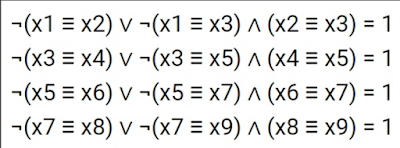Consider a system somewhat more complex than

######################
UPDATE as of 06/10/2109
########################
I do have to notice that solving System 5 from http://kpolyakov.spb.ru/download/mea-2016-8.pdf silently does what described down here without focusing attention on predicates (x3≡x4) and x3^x4 truth and false sets intersections. Actually four sets were obtained and theirs powers have been used to solve System 5. I sincerely apologize for missing this doing original post
END UPDATE
##########################
UPDATE as of 03/10/2019
##########################
See complete version of "update" here
Setting up a cross-reference table in 08/2016 approach of Helen Mironchick when moving to a new line of the system of Boolean equations
The key place is a detailed description of building a cross-reference table
when moving to a new line of the system. The chart generation is just a consequence.
First consider system
(1) F1(x1,y1,z1)=>F2(x2,y2,z2) =1
(2) F1(x2,y2,z2)=>F2(x3,y3,z3) =1
(3) F1(x3,y3,z3)=>F2(x4,y4,z4) =1
(4) F1(x4,y4,z4)=>F2(x5,y5,z5) =1
where F1 and F2 are triple predicates
Denote card(N) the power of set N
Denote n1,n2,m1,m2,s1,s2
n1=card (falseSet_F2 ∩ falseSet_F1)
n2=card (falseSet_F2 ∩ truthSet_F1)
m1=card (truthSet_F2 ∩ falseSet_F1)
m2=card (truthSet_F2 ∩ truthSet_F1)
s1=card (falseSet_F1)
s2=card (truthSet_F1)
Then following 08.2016 diagram takes place
###############
END UPDATE
###############
************
System (1)
************
(((x1=>y1)=>z1)⊕((z1=>y1)=>x1))=>((x2≡y2)≡z2)=1
(((x2=>y2)=>z2)⊕((z2=>y2)=>x2)) v ((x3≡y3)≡z3)=1
(((x3=>y3)=>z3)⊕((z3=>y3)=>x3))=>((x4≡y4)≡z4)=1
(((x4=>y4)=>z4)⊕((z4=>y4)=>x4)) v ((x5≡y5)≡z5)=1
Basic chart
In this case, the predicate G (x, y, z) = (((x => y) => z) ⊕ ((z => y) => x)) is given by a slightly more complicated function than in the previous post. In fact, any triple predicate F (x, y, z) with the power of the truth region “2” defined on 8 three-bit chains will give exactly the same number of solutions.
************
System (2)
************
Consider following system
(((x1=>y1)=>z1)⊕((z1=>y1)=>x1))=>((x2≡y2)≡z2)=1
(((x2=>y2)=>z2)⊕((z2=>y2)=>x2))=>((x3≡y3)≡z3)=1
(((x3=>y3)=>z3)⊕((z3=>y3)=>x3))=>((x4≡y4)=z4)=1
(((x4=>y4)=>z4)⊕((z4=>y4)=>x4))=>((x5≡y5)≡z5)=1
(((x5=>y5)=>z5)⊕((z5=>y5)=>x5))=>((x1≡y1)≡z1)=1
Perform two runs. First for system
(((x1=>y1)=>z1)⊕((z1=>y1)=>x1))=>((x2≡y2)≡z2)=1
(((x2=>y2)=>z2)⊕((z2=>y2)=>x2))=>((x3≡y3)≡z3)=1
(((x3=>y3)=>z3)⊕((z3=>y3)=>x3))=>((x4≡y4)≡z4)=1
(((x4=>y4)=>z4)⊕((z4=>y4)=>x4))=>((x5≡y5)≡z5)=1
(((x5=>y5)=>z5)⊕((z5=>y5)=>x5))=>((x1≡y1)≡z1)=0
Starting values for G(x1,y1,z1) are defined by
false triples ((x1≡y1)≡z1)
For 000 G(0,0,0) =0
(((x3=>y3)=>z3)⊕((z3=>y3)=>x3))=>((x4≡y4)≡z4)=1
(((x4=>y4)=>z4)⊕((z4=>y4)=>x4))=>((x5≡y5)≡z5)=1
Polyakov's Control

######################
UPDATE as of 06/10/2109
########################
I do have to notice that solving System 5 from http://kpolyakov.spb.ru/download/mea-2016-8.pdf silently does what described down here without focusing attention on predicates (x3≡x4) and x3^x4 truth and false sets intersections. Actually four sets were obtained and theirs powers have been used to solve System 5. I sincerely apologize for missing this doing original post
END UPDATE
##########################
UPDATE as of 03/10/2019
##########################
See complete version of "update" here
Setting up a cross-reference table in 08/2016 approach of Helen Mironchick when moving to a new line of the system of Boolean equations
The key place is a detailed description of building a cross-reference table
when moving to a new line of the system. The chart generation is just a consequence.
First consider system
(1) F1(x1,y1,z1)=>F2(x2,y2,z2) =1
(2) F1(x2,y2,z2)=>F2(x3,y3,z3) =1
(3) F1(x3,y3,z3)=>F2(x4,y4,z4) =1
(4) F1(x4,y4,z4)=>F2(x5,y5,z5) =1
where F1 and F2 are triple predicates
Denote card(N) the power of set N
Denote n1,n2,m1,m2,s1,s2
n1=card (falseSet_F2 ∩ falseSet_F1)
n2=card (falseSet_F2 ∩ truthSet_F1)
m1=card (truthSet_F2 ∩ falseSet_F1)
m2=card (truthSet_F2 ∩ truthSet_F1)
s1=card (falseSet_F1)
s2=card (truthSet_F1)
Then following 08.2016 diagram takes place
###############
END UPDATE
###############
************
System (1)
************
(((x1=>y1)=>z1)⊕((z1=>y1)=>x1))=>((x2≡y2)≡z2)=1
(((x2=>y2)=>z2)⊕((z2=>y2)=>x2)) v ((x3≡y3)≡z3)=1
(((x3=>y3)=>z3)⊕((z3=>y3)=>x3))=>((x4≡y4)≡z4)=1
(((x4=>y4)=>z4)⊕((z4=>y4)=>x4)) v ((x5≡y5)≡z5)=1
Basic chart
Start 08.2016 run
Polyakov's Control
In this case, the predicate G (x, y, z) = (((x => y) => z) ⊕ ((z => y) => x)) is given by a slightly more complicated function than in the previous post. In fact, any triple predicate F (x, y, z) with the power of the truth region “2” defined on 8 three-bit chains will give exactly the same number of solutions.
************
System (2)
************
Consider following system
(((x1=>y1)=>z1)⊕((z1=>y1)=>x1))=>((x2≡y2)≡z2)=1
(((x2=>y2)=>z2)⊕((z2=>y2)=>x2))=>((x3≡y3)≡z3)=1
(((x3=>y3)=>z3)⊕((z3=>y3)=>x3))=>((x4≡y4)=z4)=1
(((x4=>y4)=>z4)⊕((z4=>y4)=>x4))=>((x5≡y5)≡z5)=1
(((x5=>y5)=>z5)⊕((z5=>y5)=>x5))=>((x1≡y1)≡z1)=1
Perform two runs. First for system
(((x1=>y1)=>z1)⊕((z1=>y1)=>x1))=>((x2≡y2)≡z2)=1
(((x2=>y2)=>z2)⊕((z2=>y2)=>x2))=>((x3≡y3)≡z3)=1
(((x3=>y3)=>z3)⊕((z3=>y3)=>x3))=>((x4≡y4)≡z4)=1
(((x4=>y4)=>z4)⊕((z4=>y4)=>x4))=>((x5≡y5)≡z5)=1
(((x5=>y5)=>z5)⊕((z5=>y5)=>x5))=>((x1≡y1)≡z1)=0
Starting values for G(x1,y1,z1) are defined by
false triples ((x1≡y1)≡z1)
For 000 G(0,0,0) =0
For 101 G(1,0,1) =0
For 011 G(0,1,1) =1
For 110 G(1,1,0) =1
Thus G(x1,y1,z1) starts with 2/2
The result of first run is value G(x5,y5,z5) on line "1". It defines the number
of false solutions - 1952 , which should be deducted from number of solutions of second system.
Second run :-
Thus G(x1,y1,z1) starts with 2/2
The result of first run is value G(x5,y5,z5) on line "1". It defines the number
of false solutions - 1952 , which should be deducted from number of solutions of second system.
Second run :-
(((x1=>y1)=>z1)⊕((z1=>y1)=>x1))=>((x2≡y2)≡z2)=1
(((x2=>y2)=>z2)⊕((z2=>y2)=>x2))=>((x3≡y3)≡z3)=1(((x3=>y3)=>z3)⊕((z3=>y3)=>x3))=>((x4≡y4)≡z4)=1
(((x4=>y4)=>z4)⊕((z4=>y4)=>x4))=>((x5≡y5)≡z5)=1
Polyakov's Control










No comments:
Post a Comment